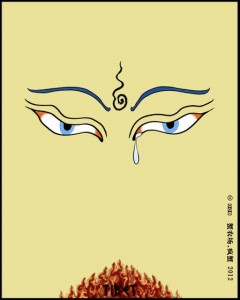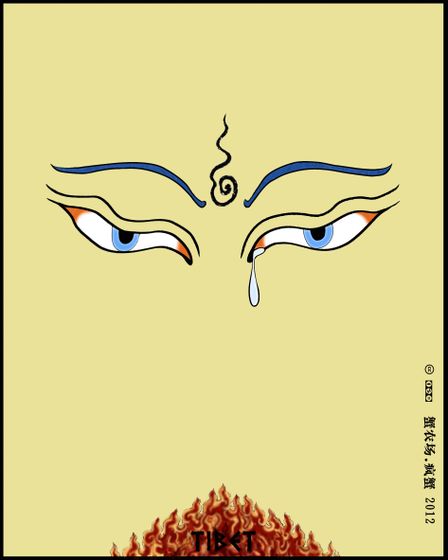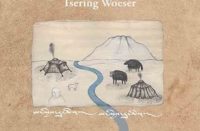High Peaks Pure Earth has translated a blogpost by Woeser written on January 11, 2012 for the Tibetan service of Radio Free Asia and posted on her blog on January 22, 2012.
This post follows up Woeser’s previous blogpost titled “Why Didn’t Kalon Tripa Read Out Tapey’s Name?” in which Woeser criticised Kalon Tripa Lobsang Sangay for omitting Tapey’s name when reading the names of Tibetans who have self-immolated. For those readers unfamiliar with the case of Tapey’s self-immolation in 2009, see anearlier article by Woeser titled “Tibet is Burning”.

“Why Are Different Numbers of Self-Immolations in Tibet Talked About?”
By Woeser
On January 6 this year, in Ngaba, Amdo, another two Tibetans self-immolated. The cases were reported by the website “Phayul” that deals with Tibet related questions and operates outside Tibet. Yet, when “Phayul” gave accounts of the continuous cases of self-immolations in Tibet, it neglected the very first case, the monk Tapey from Ngaba. When Voice of America’s Tibetan programme “Kunleng” broadcast how Kalon Tripa read out the names of the people who self-immolated in Tibet at the Kalachakra teachings, they equally failed to mention Tapey.
In view of this many cases of self-immolation happening within Tibet, if we ourselves do not even speak out clearly, how are other people in the world supposed to remember?! This is the least we should expect from ourselves; when we use numbers to calculate and convey these human lives, we must be extremely cautious, by no means should we miss out or forget anyone. At least, when we discover a mistake, it should be promptly corrected, in such matters no one should for the sake of not hurting somebody’s feelings, go with the flow and say what everybody else says. Otherwise, a small mistake in the beginning can later turn into total chaos that will be difficult to disentangle.
At the moment, this kind of chaos is already forming. In many reports and comments about the self-immolations in Tibet found in foreign media and on websites, different numbers of affected people are being put forward. The majority only count those that occurred after 2011 and hereby neglect the first case of 2009; and even with regards to the numbers of cases after 2011, there are mistakes. This may be due to the fact that there have been so many constantly differing cases. But it is more due to the fact that the Tibetan Exile Government, NGOs and media themselves have failed to clearly state the actual number, thus leading the outside world to make the same mistake as well, so in this matter, the number put forward by different people differs to such an extent. The immediate result of this is that recently, when a spokesperson of the State Department of the United States expressed his concern for the cases of self-immolation in Tibet, he only considered those that happened after 2011.
For this reason, I cannot help but take this mysterious mistake very seriously. Actually, the matter could have been very simple, if the missing out of Tapey had been put right immediately, all the subsequent chaos could have been avoided. I don’t know why but it seems that after the person in charge had made the mistake, it appeared to be a problem to put it right and thus the error had to be carried further, this is the root of the chaos today.
In my experience, it is the Communist Party of China that always speaks of itself as “great, glorious, and righteous”. Unfortunately, I have never lived in a democratic society, but according to my understanding of democracy, I believe that democratic societies do not entertain these notions of “great, glorious, and righteous”, especially because the basic task of a democracy is to control the leadership. A leader elected by the people can always be criticised by the people, so the leader does not dare to act arrogantly, but only in a humble manner; the media also does not serve the interest of the leader, but uses a big magnifying glass to find the leader’s faults… if it is not like this, how can it be called democracy?
Honestly, as Tibetans living inside Tibet under an autocratic and colonial rule and not having ever tasted the sweet nectar of democracy, I am really afraid that people will place their unlimited hope on the exile government’s leadership and as a result, generate exactly those characteristics that we are so familiar with but that we so much despise: deification, fawning on power, suppressing criticism etc. Hence, I sincerely ask all Tibetan compatriots outside Tibet for forgiveness but, if the Exile Government, NGOs and media continue to leave out Tapey, the first one to self-immolate inside Tibet in 2009, well, I will persist in raising my voice until the matter is put right.
Finally, I would like to once more tell Tapey’s story. Tapey is a monk from Kirti Monastery in Ngaba Prefecture, Amdo, he was 20 years old when he burnt himself and held up the Snow Lion flag and a photo of His Holiness the Dalai Lama on February 27, 2009; he was shot and crippled by the military police and then taken away; to the present day no one knows of his whereabouts, no one knows whether he is still alive. His decision to be the first one to self-immolate has, however, had a tremendous influence.
January 11, 2012





Pingback: On “Petty Criticism”, “Trivial Matters” and “Establishing Authority” By Woeser